Part 1: About us
Our purpose
The Controller and Auditor-General (the Auditor-General) carries out audits, performance audits, and inquiries, and reports to Parliament and the public to improve the performance of, and the public's trust in, the public sector.
The Auditor-General's role
The Auditor-General is an Officer of Parliament who carries out her role independent of executive government and Parliament, but is accountable to Parliament for the public resources she uses to do the job.
By law, the Auditor-General is the auditor of all public entities in New Zealand – a total of almost 4000 public entities, such as government departments, central agencies, Crown entities, schools, and State-owned enterprises.
All public entities are accountable for their use of public resources and powers. It is the Auditor-General's job to give Parliament and the public independent assurance about how public entities are operating and accounting for their performance.
The role also includes auditing local authorities, which are accountable to the public for the activities they fund through locally raised revenue. As well as annual audits, the Auditor-General audits local authorities' long-term plans, which are prepared every three years.
Areas of focus
The Auditor-General carries out audits and reports audit findings on:
- effectiveness and efficiency;
- waste;
- probity;1 and
- financial prudence.
The Auditor-General recommends actions to help improve public sector performance and how performance information is reported to Parliament and the public.
The Public Audit Act 2001 sets out the mandate and responsibilities of the Auditor-General. The Auditor-General's legislative mandate is confined to public entities, for which the Auditor-General:
- must carry out the annual audit requirements of the Public Audit Act 2001 and other statutes (such as the Public Finance Act 1989 and Local Government Act 2002, which set out accountability responsibilities of public entities);
- may carry out other services of a kind that it is reasonable and appropriate for an auditor to perform; and
- may carry out performance audits and inquiries.
The organisation
The work of the Auditor-General is carried out by about 350 staff in two business units – the Office of the Auditor-General (OAG) and Audit New Zealand, supported by a shared team of corporate services staff – and by auditors contracted from about 60 private sector accounting firms.
The OAG carries out strategic planning, sets policy and standards, appoints auditors and oversees their performance, carries out performance audits, provides reports and advice to Parliament, and carries out inquiries and other special studies.
Audit New Zealand is the larger of the two business units. It carries out annual audits allocated by the Auditor-General and operates from seven locations around the country. It also provides other assurance services to public entities within the Auditor-General's mandate and in keeping with the Auditor-General's auditing standard on the independence of auditors.
Figure 1 shows how all these parts fit together in our operating model.
Figure 1
Our operating model
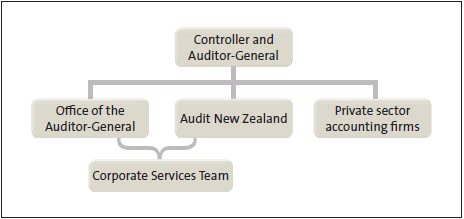
Our vision and operating intentions
Our vision is to improve the performance of, and the public's trust in, the public sector. In the medium term, our strategy is to generate greater insight and value from our work by improving our understanding of the public entities we audit, using the full range of our resources, customising our reporting, and improving the overall capability and engagement of our staff.
Strategic framework
We aim for three outcomes:
- trusted public sector;
- appropriately responsible public sector; and
- high-performing public sector.
The high-level impacts we seek are that:
- our annual audits, inquiries, and performance audits encourage public entities to respond effectively to our recommendations for improvement; and
- Parliament, local government, and other stakeholders are supported and get value from our advice.
Our outcomes framework diagram in Figure 2 summarises the outcomes we are seeking, the impacts we aim to make, and the outputs we deliver. It also shows that our work is underpinned by our organisational health and capability, which is achieved through a well-run OAG and Audit New Zealand.
We provide details about the standards we use to measure our achievements and the results of those measures for our outcomes, impacts, and outputs in previous years in the pages after Figure 2.
Figure 2
Outcomes framework
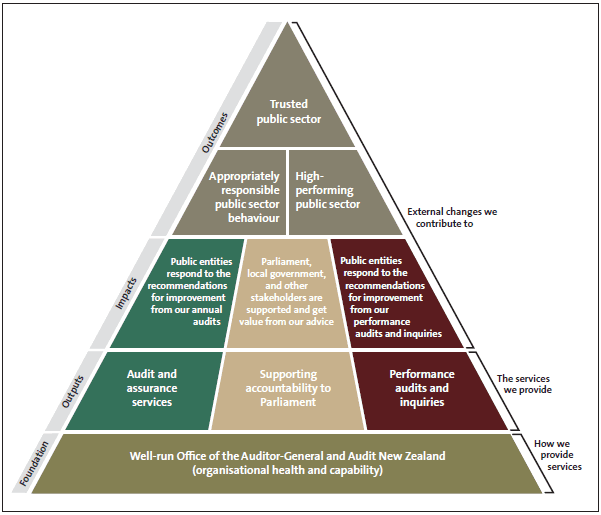

Measures and standards for achieving our outcomes, and previous performance
Trusted public sector
- New Zealand is ranked in the 90th percentile of the Worldwide Governance Indicators.
Figure 3
New Zealand's ranking in the Worldwide Governance Indicator, 2007 to 2010*
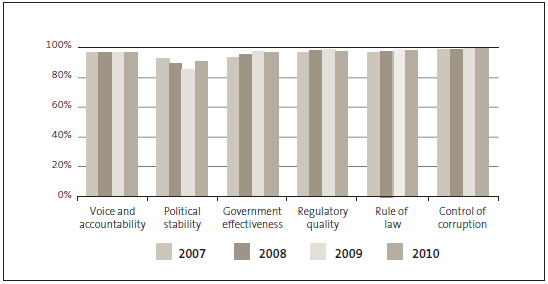
* Results are published in calendar years, and are not yet available for 2011.
- The State Services Commission's Kiwis Count Survey shows that the public's confidence that public servants do a good job is improved (or at least maintained).
Figure 4
Kiwis Count Survey results in 2008 and 2010*: Public servants do a good job

* Results are published in calendar years, and are not yet available for 2012
- New Zealand's score on the Transparency International Corruption Perceptions Index is maintained or improved. New Zealand has achieved a high place on the Index since it was started in 1995, and was rated first in the world in 2011.
Figure 5
New Zealand's score on the Transparency International Corruption Perceptions Index, 2006 to 2011*

* Results are published in calendar years.
Appropriately responsible public sector behaviour
- Public entities' financial reports fairly reflect their actual performance and are publicly available on time.
Responsible public entities provide public audited financial reports that are on time and fairly reflect their performance.
We collect information about the date an audit is completed and what our opinion says about the public entity's financial report. That information provides an indication of public entities behaviour. Audits being completed on time is an indicator that public entities are well managed and meeting their reporting responsibilities. For an audit to be completed on time, public entities must provide us the information to be audited on time.
What our audit opinions say about public entities financial reports depends on whether we agree with the information presented about their performance. An unmodified audit opinion is an indicator that public entities are reporting appropriately and in accordance with standards.
Figure 6
Percentage of unmodified audit opinions and audits completed on time

- The State Services Commission's Integrity and Conduct Survey shows improved (or at least maintained) rates of State servants who reported that State service agencies promote their standards of integrity and conduct.
Figure 7
Integrity and Conduct Survey results in 2007 and 2010*: State service agencies that promote their standards of integrity and conduct

* This survey is held every three years, and results are published in calendar years.
- The State Services Commission's Integrity and Conduct Survey shows improved (or at least maintained) rates of State servants who reported that, where they observed misconduct breaches in the past year, they reported it.
Figure 8
Integrity and Conduct Survey results in 2007 and 2010: State servants' observation and reporting of misconduct
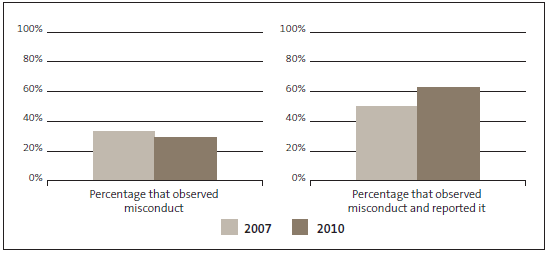
High performing public sector
- The State Services Commission's Kiwis Count Survey shows improved (or at least maintained) rates of respondents reporting that their most recent public service experience was an example of good value for tax dollars spent.
Figure 9
Kiwis Count Survey results in 2008 and 2010: Most recent public service experience was an example of good value for tax dollars spent
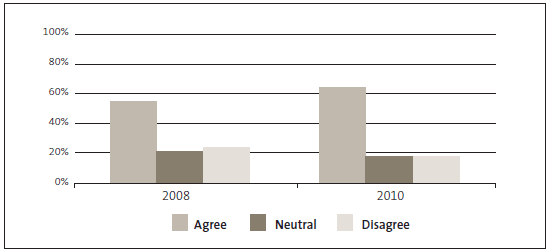
- The State Services Commission's Kiwis Count Survey shows improved (or at least maintained) rates of public satisfaction with:
- their most recent public service experience; and
- public services experienced in the last year compared with non-government agencies.
Managing in a challenging operating environment
The Auditor-General's overview identifies the challenging circumstances that continue to influence the country and this Office. The broader environment of fiscal and resource constraint is coupled with calls for public sector efficiencies and an increasing demand for a fundamental shift in the way that public services are delivered and public assets are managed. However, these challenges also bring opportunities for us to improve the assurance that we provide to Parliament and to make a positive contribution to the future delivery of public services and assets.
Our response to these challenges includes a work programme focused on the theme Our future needs – is the public sector ready? This theme reflects widespread recognition that New Zealand's public services must change and adapt to build a future we all want. Through this theme-focused audit work programme, we intend to explore issues important to New Zealand's future and to examine how the public sector is prepared for that future.
Our work will include reporting on the Christchurch earthquake recovery phase, thoroughly analysing local authorities' long-term plans, and examining important elements of future needs and preparedness through our annual audits. Our performance audits will examine specific questions for the future, such as asset management and education for Māori children.
We will also continue to respond to the range of structural governance and legislative changes in the public sector, as well as changes in accounting and auditing standards. Finally, we plan to design and implement a system to improve the sharing of information and insights collected by this Office. We are confident this will add value to our audit work and contribute to improving public sector performance.
Strategic risks and risk management
The Auditor-General faces four ongoing strategic risks. These risks are primarily managed through processes that support the work we do, as shown in Figure 10. In addition, the Office's Audit and Risk Committee, which meets four times a year, regularly reviews the Office's framework for identifying and managing risk.
Figure 10
Our strategic risks and risk management
| Risk | Management |
|---|---|
| 1. Loss of independence – Independence underpins the value of the Auditor-General's work and reporting. Losing that independence in fact or appearance, whether by failure on the part of the Auditor-General, her staff, or her appointed auditors to act independently or otherwise, would undermine trust in our organisation. | We manage this risk by applying the Auditor-General's independence standards. The Auditor-General sets a high standard for independence for her employees and the auditors she appoints to carry out audits on her behalf. Monitoring the independence standards, including for the two statutory officers and all employees, is carried out through a system that includes regular declarations of interest and, where necessary, implementing measures to mitigate conflicts of interest. Senior managers in the Office monitor and regularly assess any factors that may threaten auditor independence. We are satisfied that the Office has appropriate plans to reduce the effect of these factors to an acceptable level. |
| 2. Audit failure – the risk that we issue an incorrect audit opinion with material effect or a report that is significantly wrong in nature or process. | The Auditor-General adheres to professional auditing standards, including implementing and complying with the revised quality control standards from the New Zealand Institute of Chartered Accountants and the External Reporting Board, supplemented by the Auditor-General's auditing standards to address public sector matters not covered by general auditing standards. We monitor adherence to auditing standards through external quality assurance regimes (such as participating in New Zealand Institute of Chartered Accountants' practice reviews and, from time to time, international peer reviews). Our internal quality control procedures include carrying out quality assurance reviews of all our appointed auditors and our Office products on a risk basis and to ensure reviews of all auditors and products over a three-year period. Before performance audits are presented to Parliament, a process of external report clearance and internal substantiation and review is observed. |
| 3. Loss of capability – the risk that we are unable to retain, recruit, or access people with the technical and other skills our audit work requires. | We carry out ongoing training and development of our staff and our appointed auditors and their staff on matters necessary for audit work. We provide management programmes, leadership development initiatives, and professional development programmes for our own staff. |
| 4. Loss of reputation – the risk that we lose reputation or credibility that affects our ability to maintain effective relationships with stakeholders. This could arise either because of failings in one of the three risk areas listed above or because of external expectations and perceptions about the role of the Office or its findings on any particular matter that has been the subject of audit scrutiny. The Auditor-General's discretionary mandate is broad, and it is inevitable that we will not meet all expectations. | Managing this risk requires the exercise of judgement about where to focus our audit effort and how best to report while also achieving the greatest likelihood of public sector improvement. There are a number of ways this risk is managed in our day-to-day work:
|
1: Parliament’s and the public’s expectation of an appropriate standard of behaviour.
page top